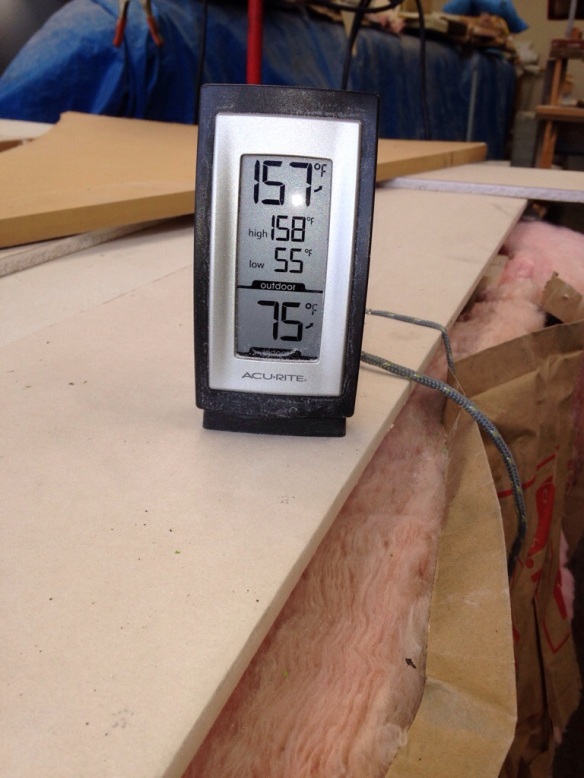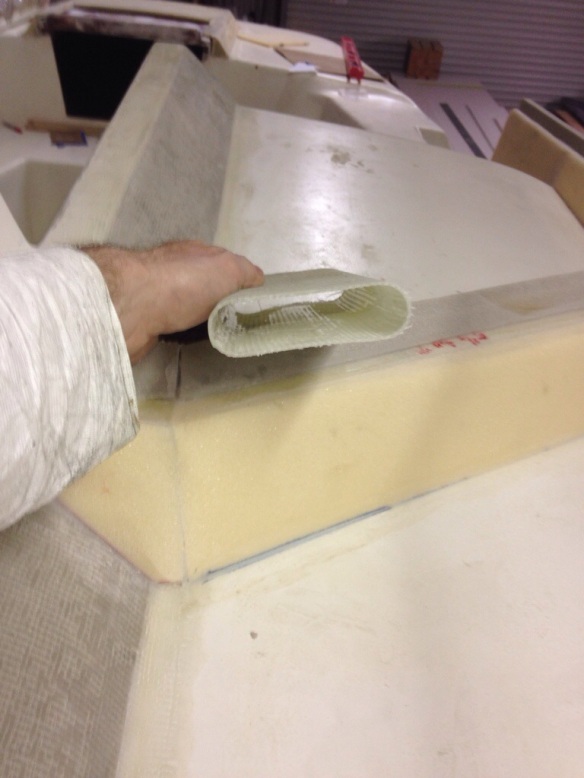It’s too bad they don’t teach this stuff in high school; no idea where one can get a hands-in education in vacuum lamination techniques. Things are being done safely here in the shop thanks to book and video study. But it’s all the little tricks not known that cause extra time and sometimes rework (go back a few posts to the vacuum pump saga :)
This week I think we’ve finally gotten in the groove, so in case anyone reading this stuff is just starting out, maybe these musings can help reduce some error in your trials?

That’s the second of four stages vacuum laminating the net lashing tubes to the hull’s port side. Significant only because it’s the first success using a splitter to draw vacuum on two separate projects in one pump run. A small moral victory around here.
Stage 3 was the 15 foot section between the main beams. Here are the steps.
Took measurements between the temporary straps, and cut all materials to leave an inch and a half on both sides of the straps so epoxy wouldn’t migrate over the straps.
Built the bag down on the 8′ work table where it can be stretched snugly and the sticky goo tape applied, leaving the paper backing in place. Setting up the tape in this calm manner, before any epoxy is mixed, took me too long to realize!
Planned for add-on patches to make out-of-the-way zones in the bag for the pump fittings to sit. Leaving at least six inches between the air connection and any live epoxy work, linked by plenty of breather fabric, keeps the glue away from the pump’s tubes and fittings. (Learned after a nasty hour of scraping out glue-fouled bag fittings one night – these parts aren’t a quick Home Depot replacement).
After cutting fglass fabric to the six inch width for this job, the ‘bagging’ supplies were cut: peel ply at 7 inches because a bit of overlap makes it MUCH easier to remove later, release film at 6″ because any more would be waste, breather fluff at 5.5″ because when it goes all the way to the edges it invariably ends up adhered where you don’t want it, like on the hull!, and the bag film itself at 11″ – leaving 2-3″ past the edge of fiberglass is minimum. For this vertical work I needed the bag to help hold the wet materials in place before the pump turned on, so I cut it close and snug on purpose.
With materials all ready, it was time to apply the putty fillet around the pipe, and let it harden up a bit, but still pliable for the bag to press the fiberglass into the fillet and be able to take by-hand smoothing from the outside of the vac bag.
Here’s the bag in place, but folded down out of the way.

Then the fglass was wetted out on the table and rolled up like little pillsbury crescent rolls (sans hot dogs, Mom) and walked over to the boat after sitting under warming lights for about 20 mins to get tacky (sticky). Here that is with peel ply to help hold it up. Note that it won’t adhere yet to the underside – gravity wins.

The heat lamps are going because there is a putty fillet above and below the pipe, trying to time it so that is just hardening when the vacuum is applied. Too early and it will squish out; too late and there will be ugly lumps in your cream of wheat.
Next shot is after applying release film and breather fluff, some of which needed dabs of masking tape to hold in place. Bag was then brought up over the work taking care to tuck things in flatly.

With this long, complicated bag, there were some air leaks but they were solved in a few minutes by pressing the tape all over again and adding a few inches of backup here and there. Having these separated tube attachment areas has helped quite a bit, compared to earlier work where I didn’t plan out the connection spots. Cut the bag to fit the work, and simply add a big ‘patch’ as needed.
All in all, no drama today and it all came out with nice, uniform tubes that need only minor fairing work. In retrospect, I probably did this all backwards; someone could try small 2-3″ fiberglass strips next to the pipe straps first. Then remove the straps after the glass strips dry, and you could probably do the whole project in fewer bagging sessions. Just a thought.
And as Jeanne’s Mom always said when preparing the fruit for canning, “I found the one we’re looking for – the last one”…. Here’s beam number four escaping the oven. Don’t ask about the electric bill. This big box is REALLY in the way, but it will stay up another day or so to bake the rudder after the last fairing work. Getting excited to start on the rudder’s cassette steering assembly!




























